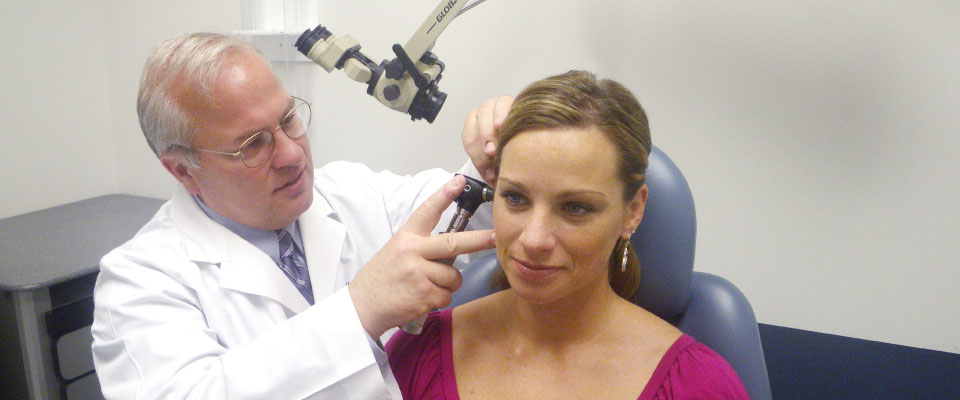Oral Lichen Planus
Oral lichen planus is a disease of chronic inflammation in the mouth. It affects one to two percent of adults, usually after the age of 40.
Patients experience patches, ulcers, or blisters inside their mouths which can vary from painless to painful and can persist for years between flareups. In almost all cases, the lining of the mouth shows lacy white patterns upon close examination.
People with oral lichen planus have an elevated risk of developing oral cancer. Therefore, it’s important for patients with this condition to consult their primary care physician about possibly establishing care with an ENT (ear, nose, and throat) specialist, or otolaryngologist.
What Are the Symptoms of Oral Lichen Planus?
If you have oral lichen planus, you may see:
- Networks of fine white lines on your inner cheeks, tongue, or gums
- Painful white patches, ulcers, or blisters on your inner cheeks, tongue, or gums
- Redness surrounding these lesions inside your mouth
- Lesions that persist for years, becoming more painful when you’re anxious or stressed
- Itchy, bumpy, purplish rash on your wrists, ankles, or lower back
What Causes Oral Lichen Planus?
The ultimate cause of oral lichen planus is unknown. It appears to be an autoimmune disease in which T-cells trigger destruction in the cells that line the mouth. Medications such as non-steroidal anti-inflammatory drugs (NSAIDs), ACE inhibitors, or beta-blockers can trigger a flareup. Certain toothpastes, dental fillings, dentures, bite injury, and infection might also contribute to the disease process.
What Are the Treatment Options?
Discuss all medications you are taking with your physician(s). Practice proper oral hygiene and talk to your dentist about possibly changing your toothpaste. Any sharp teeth near the lesions should be filed by your dentist. Fillings or dentures that are irritating your mouth should be polished or replaced. If stress and anxiety are worsening your condition, consider speaking with someone who can help you bring these conditions under control.
You might be prescribed a steroid ointment or paste to apply in your mouth after meals. An alternative prescription medication is an ointment called tacrolimus, but this might sting and burn. Tacrolimus can also be mixed as a liquid and used as a mouth rinse with success.
To reduce your risk of developing oral cancer, do not smoke, do not chew betel (the leaf of an Asian evergreen climbing plant that is used in the East as a mild stimulant), and moderate your consumption of alcohol. See your ENT specialist again if your oral lesions start to change or look different.
What Questions Should I Ask My Doctor?
- Is this oral lichen planus, or could it be something else?
- Does this spot look cancerous or pre-cancerous? Do I need a biopsy?
- Could this be caused by any medication I am currently taking?
- Would you recommend a steroid paste or ointment?
- Do stress and anxiety trigger or worsen oral lichen planus? What steps can I take to reduce my stress and anxiety?
- Will this condition get better, or might it return at a later date?
Recurrent Respiratory Papillomatosis (RRP)
Recurrent respiratory papillomatosis (RRP) is an uncommon condition caused by the human papilloma virus (HPV) that affects roughly 2,000 people in the United States.
Viral, non-cancerous warts called papillomas develop on the surfaces of the respiratory tract; most cases of RRP involve the voice box, or larynx. Occasionally, papillomas will grow in the mouth or windpipe and, in rare cases, the lungs. There are two types of RRP: adult onset and juvenile onset.
Even though papillomas are not cancerous, they are dangerous because their presence in the airway can make breathing difficult. Growth of papillomas can cause severe, sometimes life-threatening airway obstruction. After removal, papillomas tend to regrow because the virus persists in the tissue even after the growths are removed. It is important to have frequent examinations to keep the papillomas at a manageable level. While they are noncancerous, some very rare cases can become cancerous.
What Are the Symptoms of RRP?
Symptoms of RRP can include:
- Hoarseness
- Noisy, labored breathing (stridor)
- Respiratory trouble
- Chronic cough
- Feeling that something is stuck in the throat (globus)
- Recurrent pneumonia
- Snoring
- Weak crying in infants, failure to grow and gain weight at the expected rate, episodes of choking
What Causes RRP?
RRP is caused by HPV. Between 75 and 80 percent of people will be infected by HPV during their lifetime if not vaccinated against the virus. Many people infected with HPV may never develop symptoms. HPV is transmitted through genital contact, not through casual contact. It is not well understood why some people who have been exposed to the virus develop RRP and others do not.
Two specific HPV subtypes are responsible for more than 90 percent of cases of RRP: HPV 6 and HPV 11. Type 11 appears to be more aggressive and associated with airway obstruction and spreading to the lungs. Adult onset recurrent respiratory papillomatosis (AORRP) develops in the fourth decade of life whereas juvenile onset recurrent respiratory papillomatosis (JORRP) develops before age five. JORRP is more common and more severe than AORRP.
In children, HPV is likely transferred from an affected mother to the child during labor. However, C-sections do not appear to have a protective effect. Risk factors for JORRP include being a first-born child, having a vaginal delivery or prolonged labor, and the mother being under 20 years of age. In adults, less is known about the mode of transmission. Some patients are infected during infancy, but the disease may not develop until adulthood. Some evidence suggests that RRP can develop after HPV is transmitted through oral sexual contact. AORRP is worsened by tobacco use, gastroesophageal reflux disease (GERD), and radiation therapy.
What Are the Treatment Options?
Currently, there is no “cure” for RRP. The size and location of the lesions helps the treatment team decide which approach is best for each patient. The goals for treatment are to remove the papillomas, create an open airway, improve voice quality, and increase the time between surgical procedures. RRP is diagnosed by examining the upper airway by an ENT (ear, nose, and throat) specialist, or otolaryngologist, during an office visit using a camera that is inserted through the nose or mouth. Once noted, diagnosis is confirmed by biopsy.
RRP is treated with surgery to remove the benign growths from the airway without damaging the underlying tissue or organs. This is usually performed in the operating room under general anesthesia. Some patients may require surgery every few weeks while others may only require surgery twice a year or a few times during their life. Surgical techniques used to remove RRP lesions include cold excision, microdebridement, and laser removal. Cold excision is the use of sharp surgical equipment to remove papillomas. Microdebridement involves suctioning the affected area, which is then cut away by a fast-rotating blade or shaver. Laser ablation uses a CO2 laser to directly destroy the papillomas in the airway.
Certain medications, including interferon, indole-3-carbinol, and cidofovir®, may be recommended to try to reduce the rate of papilloma regrowth, thereby increasing the time between necessary surgeries. Interferon is a synthetic form of certain proteins produced by the immune system, but because of its adverse effects, it is a second-line therapy for patients with hard-to-manage severe diseases. Indole-3-carbinol is a compound found in cruciferous vegetables such as cabbage, cauliflower, and broccoli, and has been shown to slow papilloma growth.
The most common antiviral medication used in patients with RRP is cidofovir. This drug is injected into the papilloma to slow the regrowth and increase the time between therapies. Initial studies of cidofovir indicate that it’s active against RRP and may lead to a partial response in some patients and complete remission in others. However, cidofovir may also cause several side effects and has a small potential for causing the papillomas to become cancerous.
Additional drugs are being studied as potential therapies for patients with RRP, including the monoclonal antibody bevacizumab. Bevacizumab has been shown to be effective when administered intravenously after surgical removal of papillomas. This form of treatment seems especially helpful in patients with rapidly recurring papillomas in the larynx and trachea.
In some severe cases, where tumor growth is aggressive, a patient may need a tracheostomy to keep the airway open. A tracheostomy involves surgically inserting a tube into the windpipe through the front of the neck. A tracheostomy is only used as a method of last resort because the procedure may allow for the spread of disease further into the respiratory tract.
An HPV vaccine, Gardasil-9®, has been developed to protect women from developing HPV-related cancers such as cervical cancer, men from developing penile cancer, and both men and women from developing genital warts and certain cancers of the head and neck. Among the subtypes of HPV covered by the vaccine are HPV 6 and HPV 11, those that cause RRP. The use of the Gardisil-9 vaccine in children before they are exposed to the virus will drastically lessen the spread of HPV in the general population. Unfortunately, this type of vaccine does not make existing infections go away.
What Questions Should I Ask My Doctor?
- How and when did I contract HPV?
- What will you use to remove the lesions from my airway?
- Am I a candidate for in-office management of my RRP? Will I remain awake during the procedure? Are there advantages or disadvantages to this approach?
- Is laser treatment for RRP available at this institution?
- What are the risks of surgery? Will I need to be on voice rest after my surgery?
- Will I need to see a speech therapist after my surgery?
- Will the lesions return after they are removed? How will I know when they grow back?
- How often will you look inside my throat to monitor the papillomas after surgery?
- Does smoking impact my recovery from surgery?
- Will I develop cancer because I have RRP?
Ankyloglossia (Tongue-tie)
Ankyloglossia, which is also referred to as tongue-tie, is a condition where the tongue cannot move normally because it is attached to the floor of the mouth by the frenulum, which is too tight.
The lingual frenulum is the band of tissue that attaches the undersurface of your tongue to the bottom part of the mouth. Adequate tongue movement is necessary for swallowing and speech. When tongue movement is restricted, evaluation by an ENT (ear, nose, and throat) specialist, or otolaryngologist, may be necessary to check for ankyloglossia or other conditions that can affect oral and tongue function. In infants and children, ankyloglossia can sometimes cause breastfeeding and speech problems. Mild restrictions of tongue movement may not cause any speech or swallowing difficulties.
In recent years, the number of infants and children being diagnosed with and undergoing treatment for ankyloglossia has been on the rise as the condition has become more known. However, high-quality research on ankyloglossia is limited, and currently there is controversy on this topic. There are two types of ankyloglossia commonly described: anterior (when the frenulum inserts farther out toward the tip of the tongue) and posterior ankyloglossia (when the frenulum is widened at the insertion of the tongue into the floor of the mouth). Experts have failed to reach agreement on a formal classification system and management strategies. This highlights the need for individual evaluation and treatment discussions based on each patient’s circumstances. Ankyloglossia is usually identified from infancy through childhood. Some infants with ankyloglossia may have problems breastfeeding, but there are many other causes of latching difficulty that need to be considered.
The typical treatment of symptomatic ankyloglossia is a frenotomy, a surgery that involves cutting the band of tissue between the tongue and floor of mouth to release the tongue and help it move more freely. Not all patients with ankyloglossia require or would benefit from surgery, so it is critical that each patient is evaluated based on their individual symptoms to avoid unnecessary surgery. For example, an infant who has a frenulum that attaches farther out on the tongue but is feeding well does not necessarily require surgery. See the “What Are the Treatment Options?” section for more details.
What are the Symptoms of Ankyloglossia?
Symptoms of ankyloglossia may include:
- Nipple pain or irritation when breastfeeding experienced by mothers of newborn infants
- Problems latching on to the nipple during feeding experienced by infants
Ankyloglossia does not cause sleep apnea or snoring and does not typically affect speech, but it can occasionally cause problems with articulation in school-aged children. In older children and adolescents, ankyloglossia can cause social/mechanical issues including difficulty licking, difficulty keeping teeth clean, and a sense of social embarrassment. Adults with ankyloglossia may have difficulty cleaning their teeth with their tongue and problems playing wind instruments.
What Causes Ankyloglossia?
A tight lingual frenulum can cause ankyloglossia by limiting the motion of the tongue. In some cases, this band of tissue inserts too far out toward the tip of the tongue or is widened at the back of the tongue, causing problems with tongue motion. While the exact cause of ankyloglossia is still unknown, there tends to be a higher number of males with the diagnosis and is occasionally present in multiple family members. Ankyloglossia has also been associated with other genetic syndromes.
What Are the Treatment Options?
When considering treatment options for ankyloglossia and breastfeeding difficulty, it is important to remember that there is no one-size-fits-all solution. Factors such as patient age, types of symptoms experienced, other medical conditions, and surgical risks all affect the decision process between you and your doctor. Successful nonsurgical options focus on symptom management, such as working with a breastfeeding specialist on adaptive positioning and assistive devices in infants, or working with a speech therapist for articulation improvement in children.
If nonsurgical interventions do not resolve the problem or ankyloglossia is moderate to severe, a lingual frenotomy may be recommended. The procedure involves cutting the restricted frenulum with scissors, laser, or cautery device depending on the preference of the treating physician. The frenulum is divided until mobility is improved. In young infants, the procedure is often done in the doctor’s office, while older children may require anesthesia. More severe cases may require a frenuloplasty.
While many infants benefit from frenotomy, not all infants with ankyloglossia experience symptoms or require any intervention. Also, frenotomy does not resolve or improve symptoms in all patients. A few rare risks of frenotomy may include bleeding, infection, scarring, salivary duct injury, and airway obstruction. Your doctor should understand the multiple factors than can impact successful breastfeeding. An ENT specialist, speech language pathologist, lactation consultant, and other breastfeeding specialists may be needed.
What Questions Should I Ask My Doctor?
- Are there any other factors, besides tongue-tie, that may be impacting breastfeeding in my child?
- Are there nonsurgical options available to help with breastfeeding?
- Is a frenotomy necessary?
- What if ankyloglossia is not the cause of the breastfeeding difficulty?
- When is the best time for a frenotomy to be performed?
- What are the risks of frenotomy for my child?
- Does my child have any conditions that that may increase the risks associated with having a frenotomy?
- Will my medical insurance cover this procedure?
Dysgeusia
Dysgeusia is a condition where a person’s perception of taste is altered; everything seems sweet, sour, bitter, or metallic.
Taste disorders are common in adults. A study performed on adults in the United States indicated that up to 17 percent of those tested had some impairment in taste. Impaired taste can take many forms, including:
- Hypogeusia, which is a reduced or diminished sense of taste
- Ageusia, which is a complete loss of taste
- Aliageusia, when a typically pleasant-tasting food or drink begins to taste unpleasant
- Phantogeusia, which refers to tasting something that is not actually there, or hallucinating a particular taste
The tongue and throat have many taste receptors. Three different nerves contribute to the sensation of taste depending on where in the mouth the taste receptors are located. The front of the tongue is innervated, or supplied, by cranial nerve VII, called the facial nerve, through the chorda tympani; the back part of the tongue is innervated by cranial nerve IX, called the glossopharyngeal nerve; and the palate and throat are innervated by cranial nerve X, called the vagus nerve.
Completely losing taste due to injury of a nerve is rare since several nerves are involved. What some people consider a “taste,” such as “hot and spicy” or “chemical,” may be detected through pain and other receptors working through a completely different nerve, cranial nerve V, called the trigeminal nerve. There are even some taste receptors in the nose, but doctors are still figuring out exactly what role they play.
Humans can detect five different tastes: sweet, salty, bitter, sour, and savory, or umami. It is important to recognize the difference between taste and flavor. Flavor is a multisensory experience that combines both the smell and taste of foods and drinks. While eating, the smell of food is detected through both the front of the nose and the back of the throat. Depending on the path the smell takes, it can have a different effect. When people lose their sense of smell, they often complain of a loss of taste but what they really mean is that they have lost that combination of smell and taste, or flavor.
What are the Symptoms of Dysgeusia?
The symptoms of dysgeusia can include:
- Food has lost its characteristic sweetness or saltiness
- Foods that used to taste good now taste bad (sour or rotten)
- Foods taste metallic
- A taste is present despite not eating anything
What Causes Dysgeusia?
Taste disorders are common in adults and can be caused by several factors, such as:
Infection—Bacterial, viral, or fungal infections of the teeth or gums, mouth, and throat can cause swelling, reduce blood flow to taste buds, and/or produce chemicals that alter taste. Some genetic disorders can also make some people crave sweet foods, which can then lead to dental infections that can cause even more taste issues.
Inflammation—Swelling of the tongue can cause the taste pores on it to close. This can sometimes indicate vitamin deficiencies, such as lack of B12.
Vitamin or mineral deficiencies—Deficiencies in the B vitamins, especially B12, as well as certain minerals like zinc have been associated with loss of taste. Supplements can usually reverse this.
Dry mouth—Dry mouth, or xerostomia, can be a result of certain diseases, like Sjogren’s syndrome where the body attacks its only saliva glands, common medications such as water pills, or diuretics, or from radiation therapy for cancer. Without adequate amount of saliva, food may not dissolve enough to stimulate the taste receptors.
Medication side effects—A variety of medications can cause taste issues. Common ones include angiotensin-converting-enzyme (ACE) inhibitors such as lisinopril or captopril; antibiotics such as amoxicillin, clarithromycin, and metronidazole; diuretics such as acetazolamide and hydrochlorathiazide; and chemotherapy agents, such as bleomycin and carbo/cisplatin.
Nerve damage or trauma—The nerve that supplies the front part of the tongue travels through the ear and splits off from the facial nerve. As a result, Bell’s palsy and some ear surgeries can cause a loss of taste. Also, any injury to the other nerves that are responsible for taste due to trauma or surgery in the neck may also cause this problem.
Neurologic disorders—As seen with loss of smell, certain neurologic disorders such as multiple sclerosis, Alzheimer’s disease, and Parkinson’s disease have been associated with decreased taste.
Metabolic disorders—Kidney disease, diabetes, and hypothyroidism can all cause taste disturbances that can be reversed when treated.
Tobacco use—Active chemicals in tobacco as well as the changes that take place on the surface of the tongue and throat from tobacco use can change the perception of taste.
Acid reflux or GERD—Stomach acid and stomach enzymes can affect how well the taste buds work. Often, people with acid reflux or GERD complain of a “brackish” or sour taste.
Aging—The sense of taste can decrease with age, although this is less common than the loss of smell.
What Are the Treatment Options?
The treatment options for an impaired sense of taste depend on the exact cause for the dysgeusia or hypogeusia. With mineral or vitamin deficiencies, simply supplementing with a multi- or specific vitamin (B12, B-complex, and zinc) may be helpful. If due to medications, switching to a different medication may help restore a normal sense of taste. Managing other disorders that can trigger loss of taste, such as diabetes, thyroid disorders, or kidney problems, may also lead to improvement.
Reducing or stopping smoking or other forms of tobacco use as well as managing acid reflux either with medications or dietary modifications cannot be overemphasized. Drinking plenty of water can also help with dry mouth due to Sjogren’s, radiation treatment, or age-related loss of taste.
What Questions Should I Ask My Doctor?
- Do I have a loss of taste or is it from a loss of smell?
- Could my medications be causing this?
- Could my impaired taste be a sign of some other disease?
- Are there supplements that might help?
- What other things can I do to help improve my sense of taste?














